Minds On
Roles and responsibilities
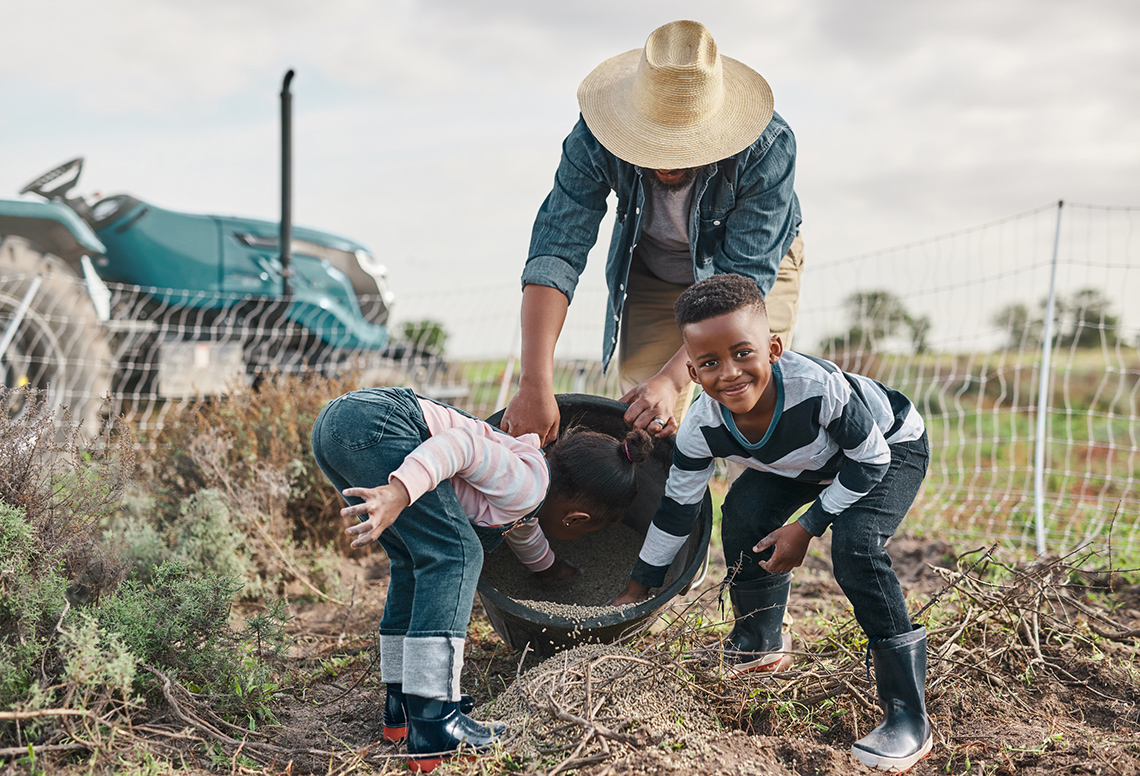
In daily life, everyone has roles and responsibilities. Consider your own roles and responsibilities.
In this video, Stella shares one of her daily responsibilities, walking her dogs.
Create a list of your daily responsibilities. You can use the following fillable and printable Daily Responsibilities Chart or another method of your choice to complete this activity.
Press ‘Hint’ to access a hint about daily responsibilities.
Complete the Daily Responsibilities Chart in your notebook or use the following fillable and printable document.
|
Roles and responsibilities |
My daily responsibilities |
Daily responsibilities of people living in the late 1700s and early 1800s |
|---|---|---|
Press the ‘Activity’ button to access the Daily Responsibilities Chart.
Now, consider what settlers' daily responsibilities might have been living in Upper Canada (now called Ontario) in the late 1700s to early 1800s. What would their responsibilities be? How are these different from your life today?
Record the daily responsibilities people would have had in this time in your chart or a method of your choice.
Compare your two lists. How similar are they?
Action
Anishinaabeg daily life in the 1700s and 1800s
The traditional territory of the Anishinaabeg covers land in Saskatchewan, Manitoba, a large portion of Ontario, and into Quebec. It also covers land in the United States.
At the time of European settlement, Anishinaabeg communities worked in partnership with the French as traders in the fur trade and in battle. When the settlers came, the Anishinaabeg signed treaties with the settlers but many of these treaties were unfairly in favour of the settlers. Throughout history these treaties have not always been respected.
Press ‘Definition’ to access the definition of treaties.
How did the Anishinaabeg spend their days in the late 1700s and early 1800s?
Before settlers arrived, the Anishinaabeg lived in wigwams or log cabins and had a relationship with the land as they hunted, fished, and did other traditional activities. When the Anishinaabeg were forced to move from their traditional land, their lifestyles changed a lot because they were no longer able to access these important areas.
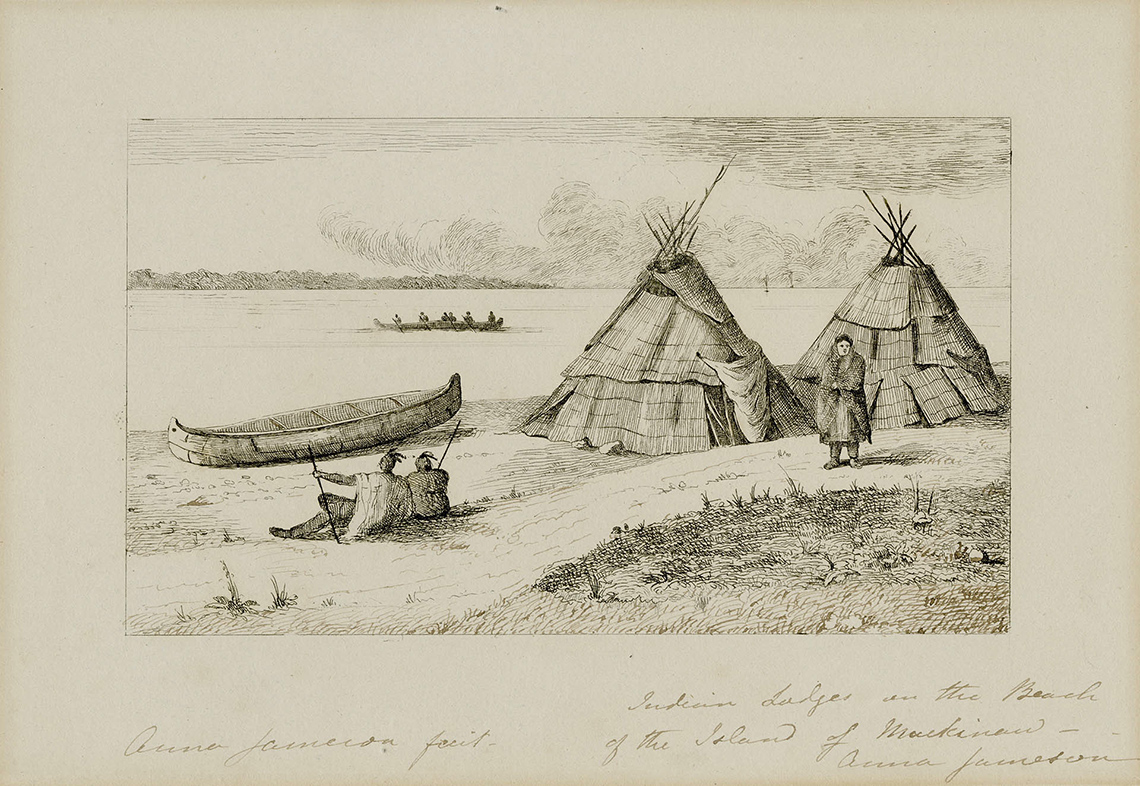
Anishinaabe wigwam on Mackinac Island 1837.
By the 1800s, however, some Anishinaabeg like the Mississaugas of the Credit First Nation were moved onto reserves where they cleared the land and built log cabins.
Press ‘Definition’ to access the definition of reserves.
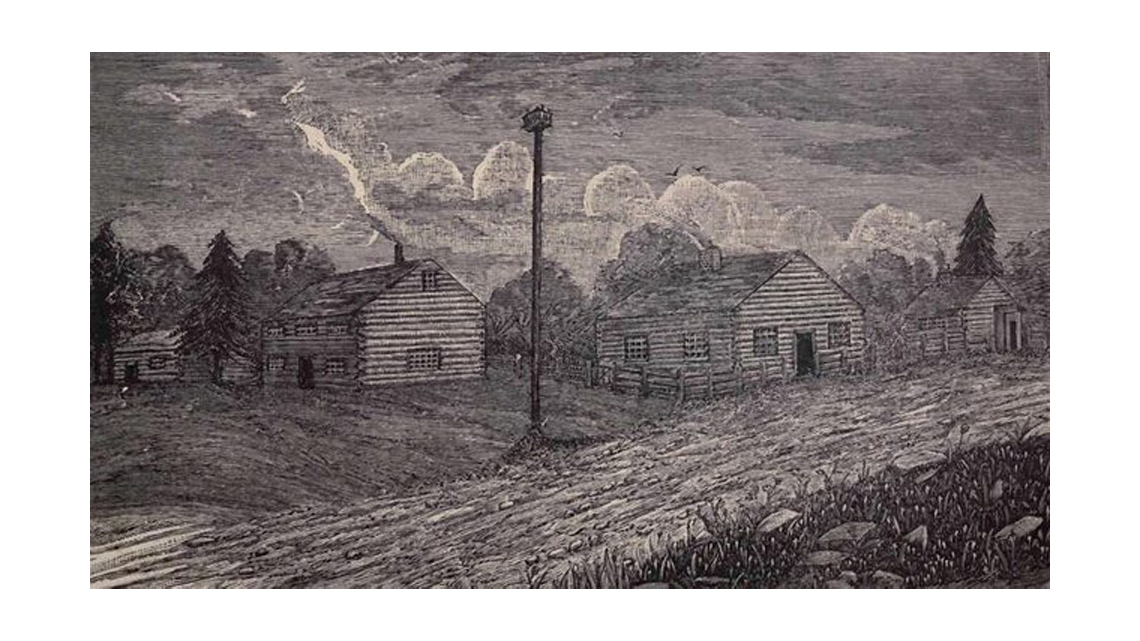
Sketch of the Mississauga of the Credit First Nations’ village in 1827 located in Upper Canada.
Most of these Nations hunted, gathered plants, nuts, berries, roots, and medicines from the land, and farmed the land.
Women harvested wild rice from the waterways, and plants, berries, and nuts from the forests and fields.
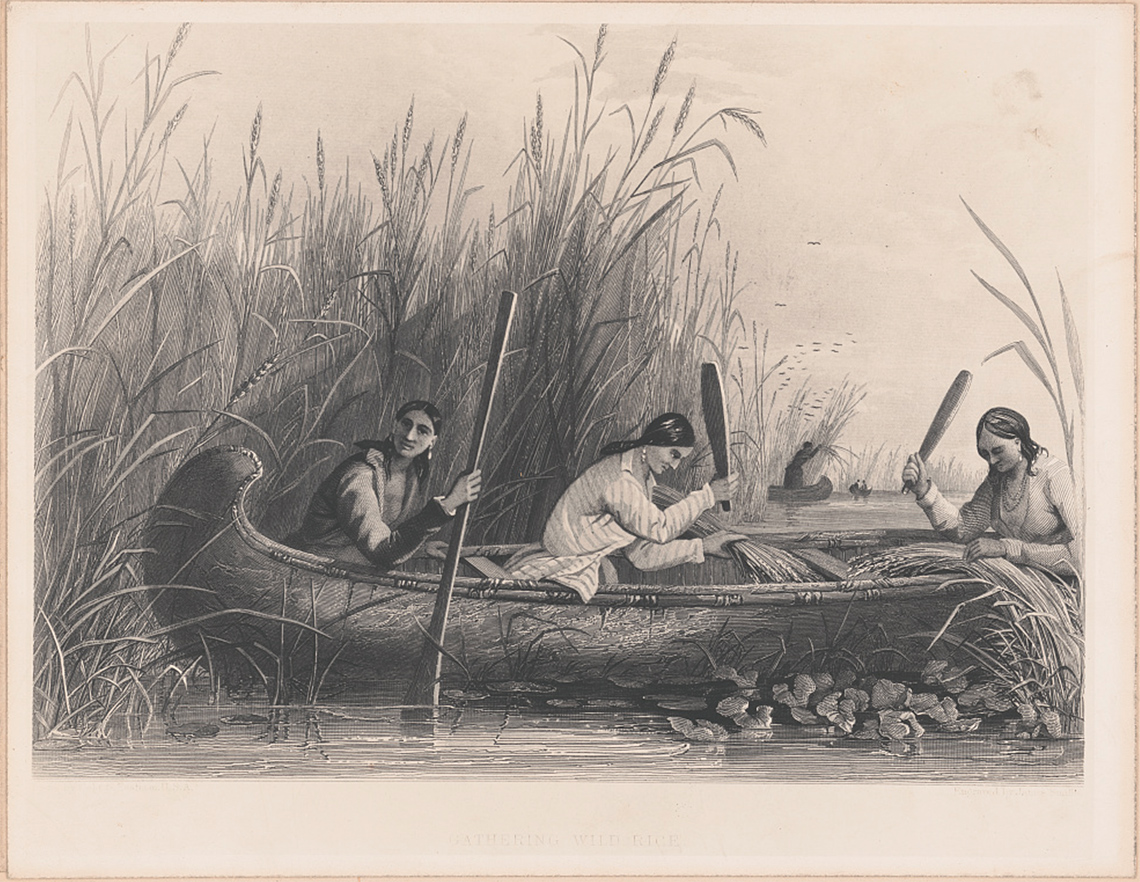
"Gathering Wild Rice" by Seth Eastman 1850
In the spring women made syrup from maple sap and birch sap. They also made and repaired fishing nets, baskets, and clothing.
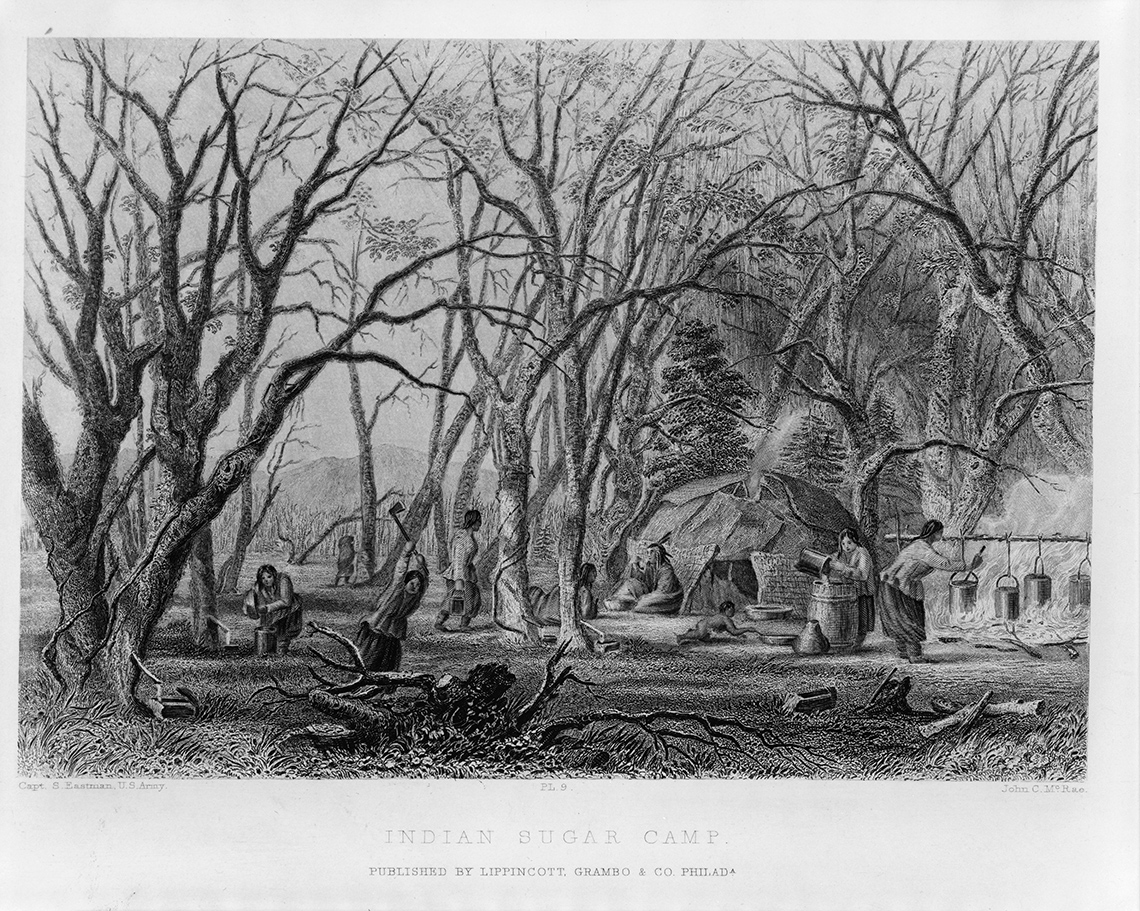
"Sugar Camp" by Seth Eastman 1853
The men in the communities hunted and trapped animals for food, made tools, and built their homes. Men also helped to care for the children. They taught boys how to make tools and how to hunt and fish. Although at this time, men were often given the title Chief in Anishinaabeg communities, women played an important role in choosing the Chief. Today "Chief" is a title given to all genders.
Chiefs were and continue to be leaders in their communities. However, each person had jobs and responsibilities to make sure that every person in their community was taken care of.

Dome shaped wigwam covered in bark and animal hide at an Ojibwe encampment in Sault Ste Marie, 1845
All adults were able to participate in storytelling, artwork, music, dancing, and harvesting traditional medicines as well as fishing. Men and women would work together to build canoes and wigwams. Both men and women were responsible for teaching children what they needed to know to live a good life.
Children hunted with their fathers and fished with their mothers and fathers. They harvested crops and vegetables with their mothers and helped with younger children. Children would gather firewood, and in the winter older children would help to chop holes in the frozen waterways to get water and to fish. Children would learn by doing; they were shown how to do something and then encouraged to try.
Use the information you have learned about the Anishinaabeg to complete this fill in the blank activity.
For each sentence, select the missing word from the drop-down menu.
Settler daily life in the 1700s and 1800s
Across what we now call Canada, settlers were given land to settle by the British government.
Daily life for these settlers was about providing the basic needs, such as keeping warm and providing food, water, and shelter.
Settlers had the difficult task of building their homes and communities. The following image is an example of a settler home. This house was built by Daniel and Elizabeth Fisher Stong in 1816. It is the oldest house in the Black Creek Pioneer Village, a settler community in what is now Toronto.
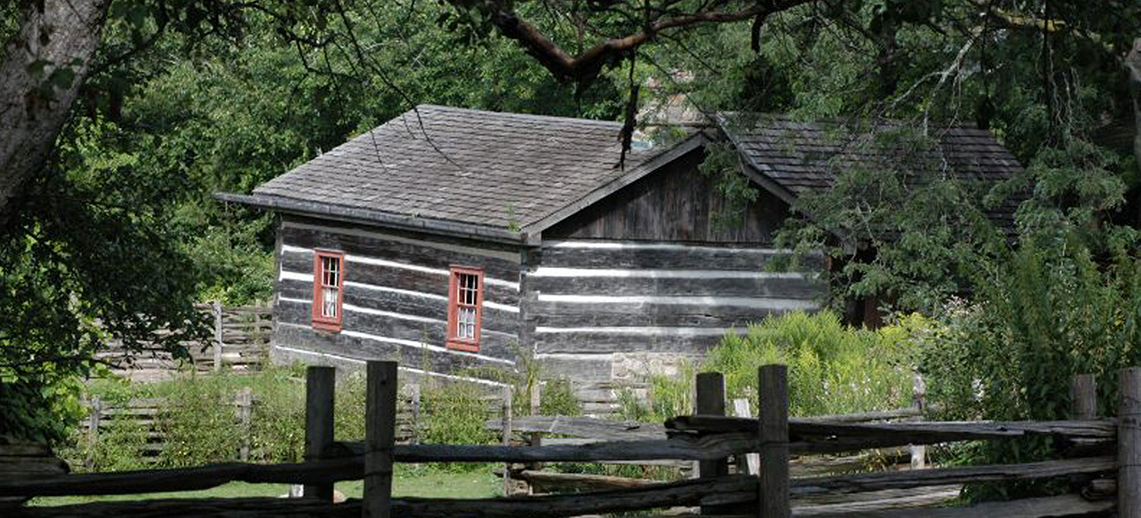
Daniel Stong's original cabin from 1816 (Black Creek Pioneer Village)
Most of the women in these settler communities worked at home. Some were teachers or help in wealthy families’ homes, ran inns (places for people who were travelling to stay), or were dressmakers. Some wealthier women in settler communities did not work, but most of the women worked in their own homes. Women often cared for the children, took care of their home, and took care of the family’s money as well. Women also cared for the animals and planted and harvested the gardens.
Some women had jobs outside of their home as well. They were teachers or helped in wealthy families’ homes, ran inns (places for people to stay when travelling), or were dressmakers.
Some men in the community had jobs that paid well and allowed them to live easier lives than others. These would have mostly been men who worked for the British government. Most of the men in the community cleared the land, built and maintained their homes and sheds, created the gardens, and cared for the soil. They also cut trees for building and for firewood.
Children had many chores to complete throughout the day. They carried the firewood for fires, peeled and chopped food to prepare for meals, fetched water, and gathered eggs. They also helped to harvest vegetables and crops. Some children weren’t able to go to school because most children worked at home.
Use the information you learned about Upper Canada settlers to complete this fill in the blank activity.
For each sentence, select the missing word from the drop-down menu.
Review questions
- What are two similarities between daily life in Anishinaabeg communities and Upper Canada settler communities?
- What are two things that are not the same between daily life in Anishinaabeg communities and Upper Canada settler communities?
Press ‘Answers’ to access the answers to the review questions.
Differences – some roles and responsibilities in Anishinaabeg are not only done by men or women, Anishinaabeg have Chiefs, some women in settler communities worked for other families
Consolidation
Daily life today
Now that you have learned about daily life in two separate communities, let’s consider these communities today. Daily lives in these communities have helped to create the Canada we live in today.
Javier
In this video, we meet Javier. Javier and his family are Anishinaabeg (Ojibwe). They live on Manitoulin Island and Javier shares his daily chores.
Use the information from the video about Javier to complete the following fillable and printable Roles and Responsibilities Chart. You can also complete this chart in your notebook or use another method of your choice.
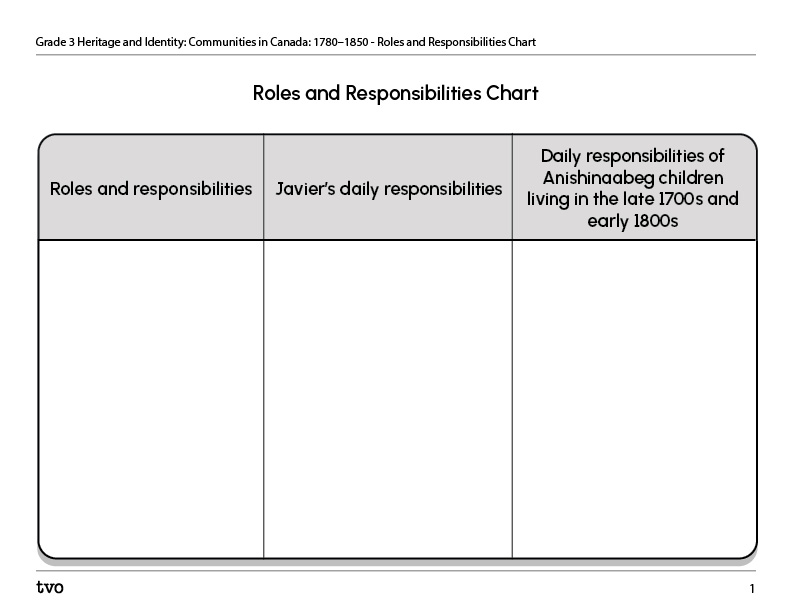
Press the Activity button to access the Roles and Responsibilites Chart.
Activity(Opens in a new tab)Cody
In this video, Cody shares his daily life with his family on his farm.
Use the information from the video about Cody to complete the following fillable and printable Roles and Responsibilites Chart. You can also complete this chart in your notebook or use another method of your choice.

Press the Activity button to access the Roles and Responsibilites Chart.
Activity(Opens in a new tab)Reflect
In what way did life in the early 1800s have an impact on Canada today? Use Javier and Cody’s stories to help you answer the question.
Reflection
How do you feel about what you have learned in this activity? Which of the next four sentences best matches how you are feeling about your learning? Press the button that is beside this sentence.
I feel...
Now, record your ideas about your feelings using a voice recorder, speech-to-text, or writing tool.